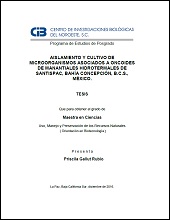| dc.contributor.advisor | López Cortés, Alejandro | |
| dc.contributor.author | Gallut Rubio, Priscila | |
| dc.date.issued | 2016 | es_MX |
| dc.identifier.uri | http://dspace.cibnor.mx:8080/handle/123456789/548 | |
| dc.description.abstract | La diversidad filogenética y funcional de microorganismos de ventilas hidrotermales intermareales de Bahía Concepción, B.C.S., México ha sido poco estudiada. Sin embargio, estos sistemas han atraído la atención de científicos por ser modelos del origen de la vida en la Tierra, en otros planetas y por presentar microorganismos con capacidades metabólicas de interés en biotecnología. En este estudio se determinó la composición elemental de macroestructuras denominadas oncoides, que se desarrollan en manantiales hidrotermales intermareales de Playa Santispac, B.C.S., encontrando por análisis semicuantitativo a los siguientes elementos: Ag, Au, As, Co, Cu, Cl, Ca, Cd, Fe, Na, Mg, Mn, O, Si y S; mientras que por medio del análisis cuantitativo se detectaron: Ag, Al, As, Ba, Be, Ca, Cd, Co, Cr, Cu, Fe, K, Mg, Na, Mn, Ni, P, Pb, Sb, Se, Sn, Sr, V, Zn. Con estos resultados se reporta por primera vez la presencia de Ag, Au, Be, Cr, Cl, K, Na, P, Pb, Sb, Se, Sn y Sr en el sistema hidrotermal de playa Santispac, B.C.S. En base a las concentraciones obtenidas del análisis cuantitativo, los elementos más abundantes en el oncoide correspondieron al Mn (138312 mg kg-1), Mg (28531 mg kg-1) y Ca (56606 mg kg-1). Metales y metaloides tóxicos fueron encontrados: As (550 mg kg-1), Ba (950 mg kg-1) y V (770 mg kg-1). Con la finalidad de incrementar el conocimiento de la diversidad de bacterias aerobias mesófilas de los oncoides, en este trabajo se aislaron 22 cepas, de las cuales se identificaron a los géneros Nitratireductor, Ornithinibacillus, Bacillus; y a las especies Bacillus licheniformis y Synechococcus elongatus a partir de las secuencias parciales del 16S ARNr. Los cultivos obtenidos en este trabajo pueden ser empleados como modelos de estudio para la identificación y análisis de los mecanismos genéticos y bioquímicos responsables de la resistencia bacteriana a metales y metaloides con fines de biorremediación. | es_MX |
| dc.language.iso | Español | es_MX |
| dc.publisher | Centro de Investigaciones Biológicas del Noroeste, S.C. | es_MX |
| dc.title | Aislamiento y cultivo de microorganismos asociados a oncoides de manantiales hidrotermales de Santispac, Bahía Concepción, B.C.S., México. | es_MX |
| dc.type | Tesis | es_MX |
| dc.documento.id | gallut_p | es_MX |
| dc.documento.inst | CIBNOR | es_MX |
| dc.dirtesis.grado | Maestría en Ciencias en el Uso, Manejo y Preservación de los Recursos Naturales | es_MX |
| dc.dirtesis.disciplina | Biotecnología | es_MX |
| dc.dirtesis.universidad | Centro de Investigaciones Biológicas del Noroeste, S.C. | es_MX |
| dc.dirtesis.facultad | Posgrado en Recursos Naturales | es_MX |
| dc.documento.fecha | 2016-12-09 | |
| dc.description.abstracten | The phylogenetic and functional diversity of microorganisms from intertidal hydrothermal springs in Bahía Concepción, B.C.S., México have scarcely been studied. However, these systems have attracted the attention of scientists as models for the origin of life on Earth, on other planets and for harboring microorganisms with metabolic capacities of biotechnological interest. In this study it was determined the elemental composition of macrostructures termed oncoids, which are developed in intertidal hydrothermal springs of Santispac beach, B.C.S., finding by a semi-quantitative analysis the follow list of elements: Ag, Au, As, Co, Cu, Cl, Ca, Cd, Fe, Na, Mg, Mn, O, Si, and S. Through quantitative analysis, we detected: Ag, Al, As, Ba, Be, Ca, Cd, Co, Cr, Cu, Fe, K, Mg, Na, Mn, Ni, P, Pb, Sb, Se, Sn, Sr, V, and Zn. With these results its reported for the first time the presence of Ag, Au, Be, Cr, Cl, K, Na, P, Pb, Sb, Se, Sn and Sr in the hydrothermal system of Santispac beach, B.C.S. Based on the concentrations obtained from quantitative determinations, the most abundant elements found in the oncoid were Mn (138312 mg kg-1), Mg (28531 mg kg-1) and Ca (56606 mg kg-1). Toxic metals and metalloids were found: As (550 mg kg-1), Ba (950 mg kg-1) and V (770 mg kg-1). With the goal of increasing the knowledge of the diversity of mesophilic aerobic bacteria of oncoids, we isolated 22 strains of aerobic mesophilic heterotrophic bacteria, of wich were identified the genera Nitratireductor, Ornithinibacillus, and Bacillus; and the species Bacillus licheniformis and Synechococcus elongatus from the partial sequences of 16S rRNA. The cultures obtained in this study could be used as study models for identification and analysis of the genetic and biochemical mechanisms responsible for bacterial resistance to metals and metalloids whit bioremediation purposes. | es_MX |
| dc.documento.subject | Manantiales hidrotermales intermareales; oncoides; composición elemental; bacterias heterótrofas mesófilas; 16S ARNr | es_MX |

